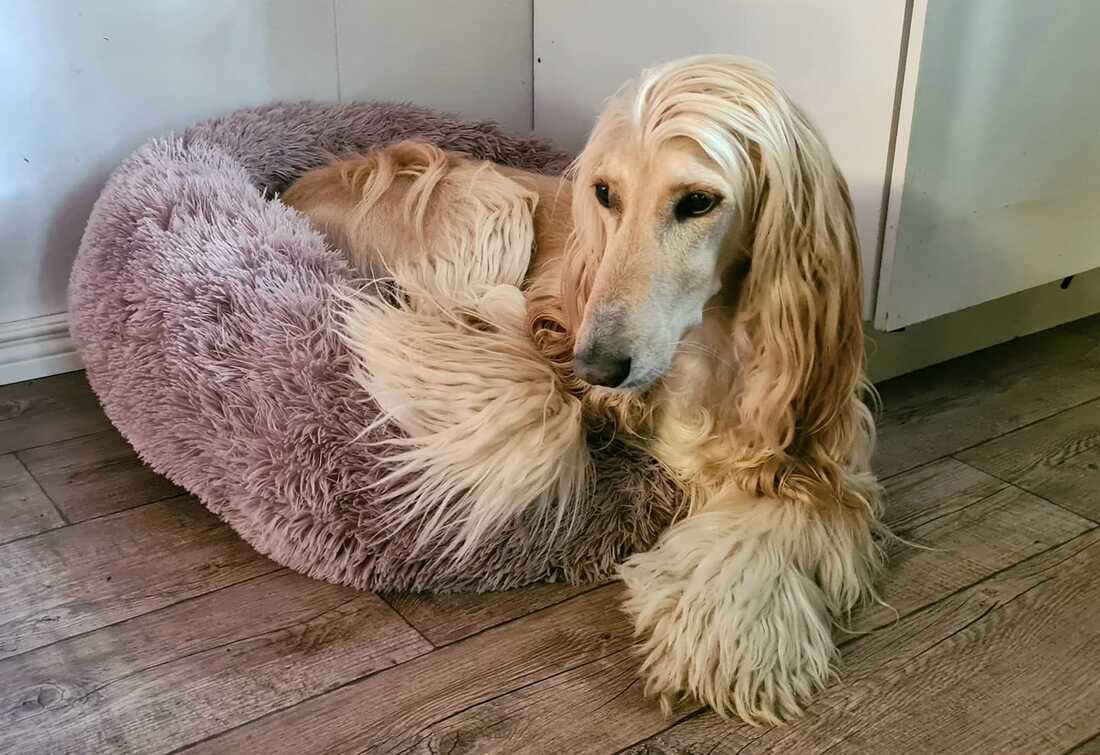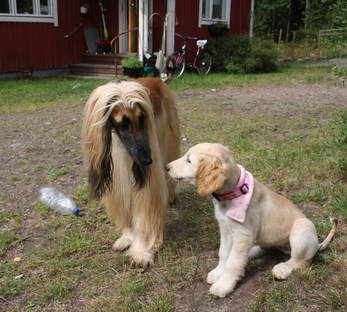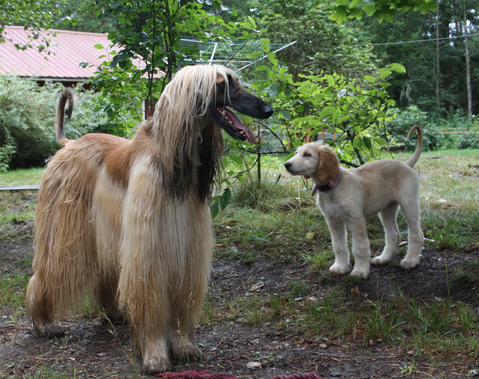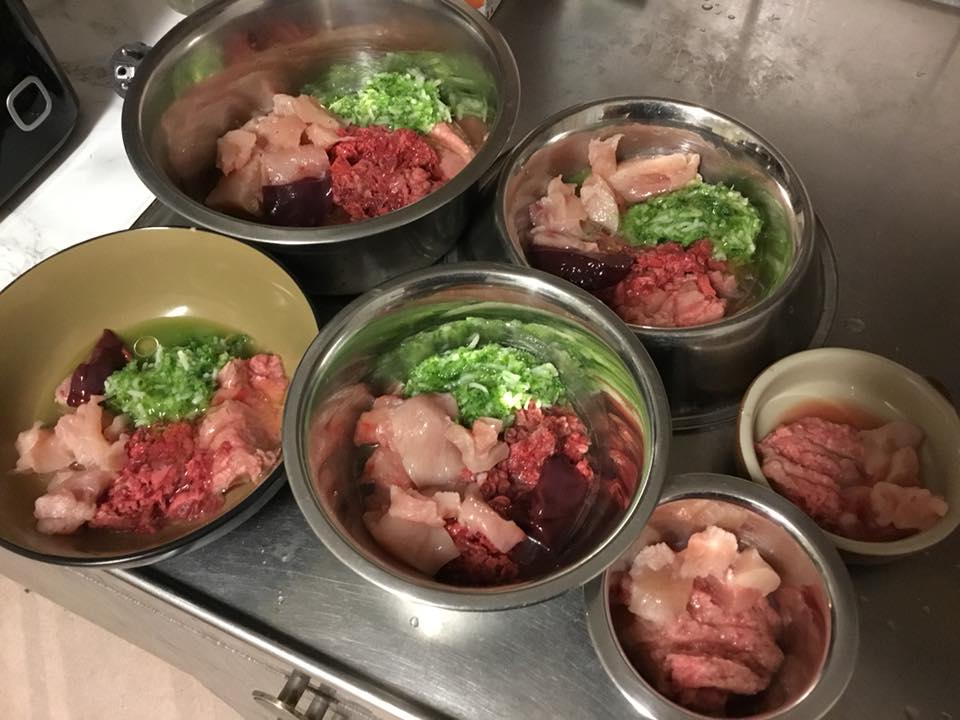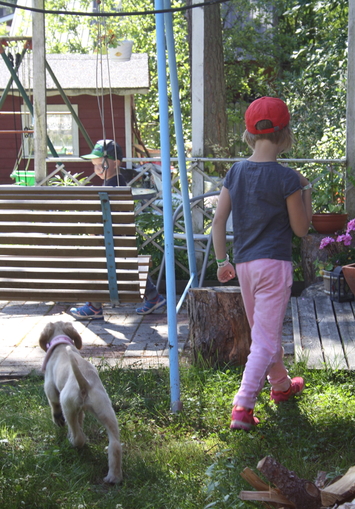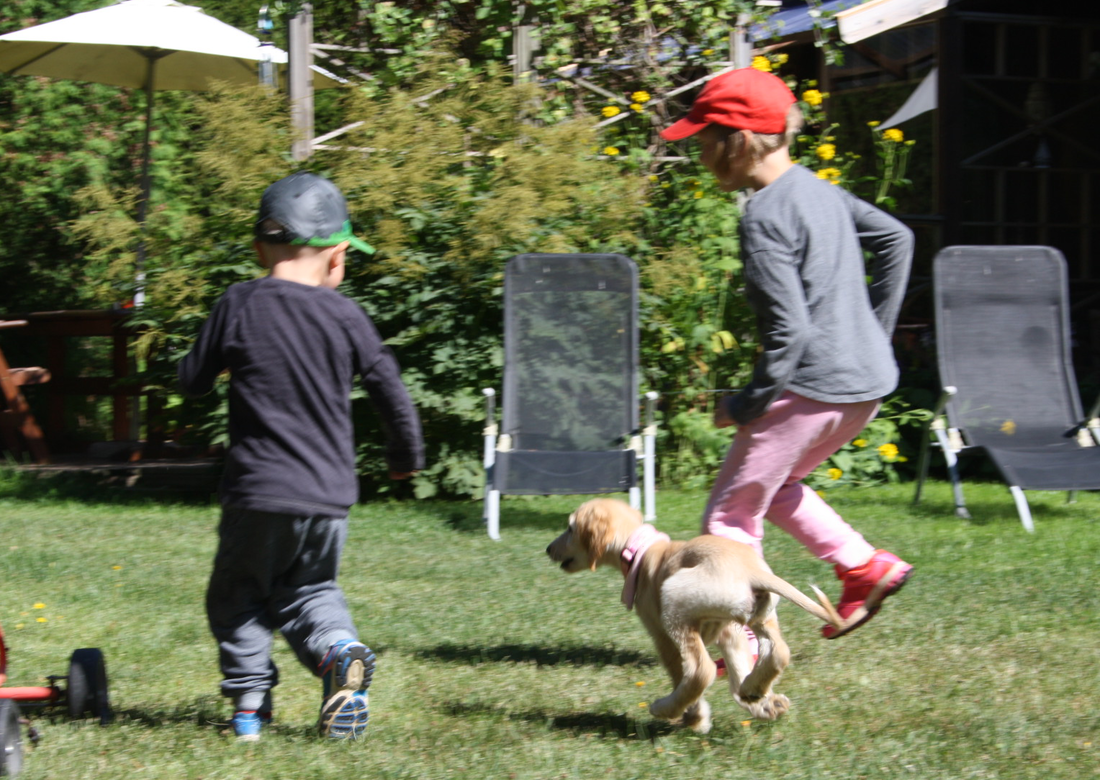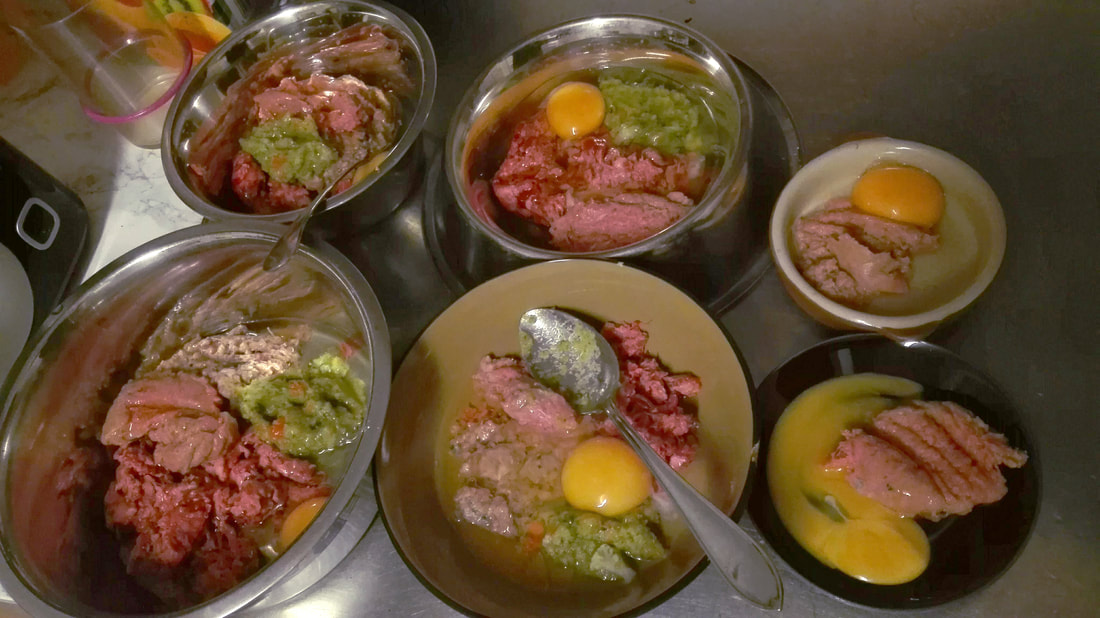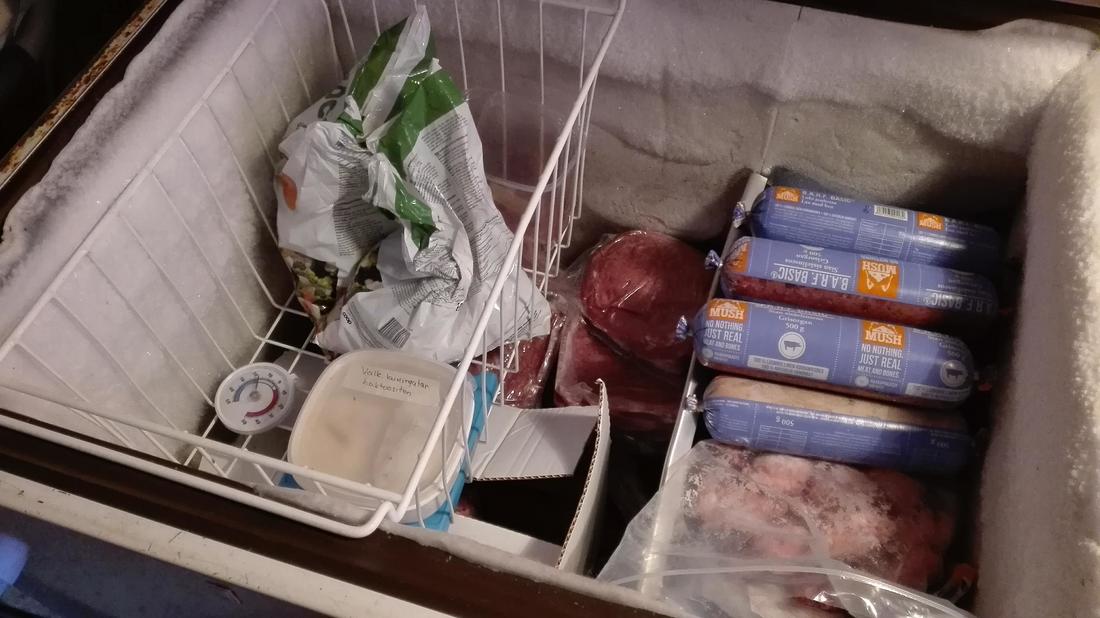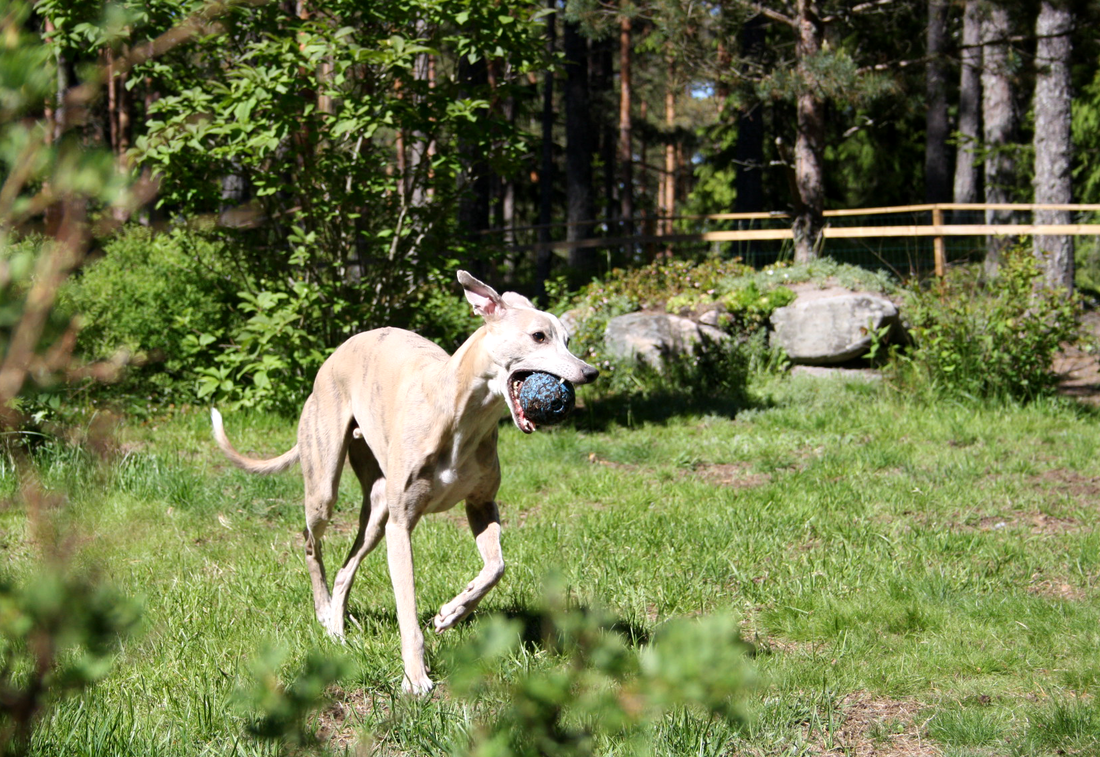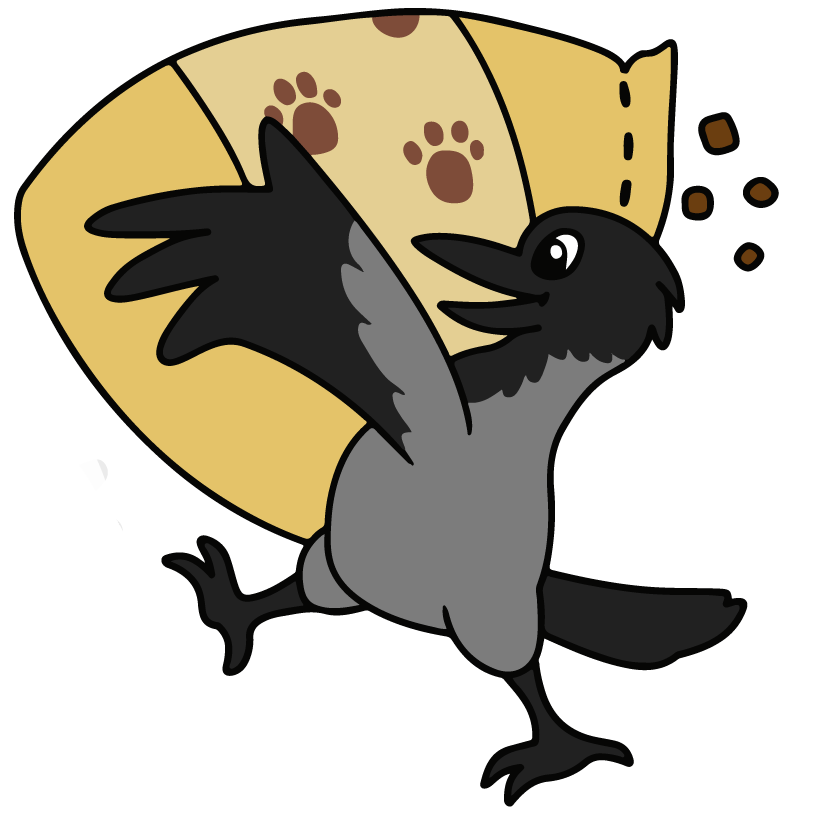|
Sivusin aihetta pari blogipostausta aiemmin puhuessani roduntuntemuksesta ja siitä, että osa koirista tarvitsee aikaa. Koen aiheen olevan kuitenkin niin tärkeä, että se ansaitsee ihan oman postauksensa siitäkin huolimatta, että syksy on taas tehnyt sormistani jäykät ja kipeät. Koirat kehittyvät kaikki yksilöllisesti ja omaan aikaansa. Osa koirista on varsin rauhallisia yksivuotiaina, osa on vielä täysin pentuja. Koirien kehityskaaresta on tehty kaikenlaisia karkeita arvioita suurinpiirteisine ikään liittyvine virstanpylväineen. Yksi tällainen esitellään hankikoira.fi-sivustolla. Pidän tätä itse varsin hyvänä rankana ja suuntaa antavana näkemyksenä. Ensiviikkojen ja murrosiän jälkeen mainitaan koiran olevan yleensä aikuinen n. 2-3 vuoden iässä. Me kuitenkin odotamme usein saumattoman hyvää ja moitteetonta käytöstä jo koiranpennuilta, teinikoirista puhumattakaan. Tämä on epäreilua, typerää ja edesvastuutonta ja johtaa pahimmillaan räikeisiin, jopa väkivaltaan johtaviin turhautumisen ja ahdistuksen tunteisiin. 6kk iässä sinä opit tunnistamaan äitisiEn voi sanoa tietäväni ihmislapsien koulua edeltävistä ikävuosista aivan valtavasti, mutta tiedän sen verran, että n. puolivuotias ihminen on oppinut tunnistamaan vanhempansa ulkonäköperusteisesti ja äänestä, osaa maata selällään ja osaa jo jotenkuten hallita päänsä liikkeitä. Arvaa, mitä me odotamme tämän ikäisiltä koirilta? Moitteetonta odottamista, hyvää käytöstä, loikkimattomuutta, käskyjen tunnistamista ja noudattamista, hienoa hihnakävelyä, jättämistä, sisäsiisteyttä, laumakäytöksen alkeita ja kontaktia. On aivan totta, että koirat ja ihminen ovat eri lajia. Koira kehittyy nopeammin. On kuitenkin epäreilua, miten me edellytämme koirilta aikuismaisen hallittua käyttäytymistä niiden vielä käydessä läpi varhaispuberteettiaan. Itse asiassa, osa koirista ei ole vielä edes aloittanut teini-ikäänsä 6kk ikäisenä. Silti me odotamme niiltä jo hyvää itsehillintää ja tottelevaisuutta. Osa koiranomistajista ei yksinkertaisesti tunnista koiran kehitysvaiheita. Toinen puoli tunnistaa, mutta ryhmäpaine ja omat odotukset saavat ne unohtumaan. Kovat odotukset sekä ulkopuolisilta että itseltä yhdistettynä pennun/teinikoiran arvaamattomaan käytökseen ja sille täysin luonnollisiin temppuiluihin johtavat turhautumiseen. Turhautuminen taas usein johtaa kiukkuun ja kiukku purkautuu koiraan. Toinen turhautumisen mahdollisista purkautumisteistä on välinpitämättömyys, apaattisuus ja turtuminen - ei jakseta tehdä mitään eikä puuttua mihinkään, koska mistään ei tunnu olevan apua. Jos kiehuu yli (KUN kiehuu yli)Jokainen meistä suuttuu ja jokainen meistä turhautuu. On valhetta väittää, etteikö koiranomistajana koskaan löytäisi itseään tilanteesta, jossa kuppi kaatuu, pato murtuu, viimeinen korsi katkaisee naapurinkin kamelin selän ja verisuoni tykyttää otsassa niin, ettei muuta kuulekaan. Vaatii itsehillintää, ymmärrystä ja osaamista toimia kiihtymyksen alaisena. Meidän on muistettava, että olemme tekemisissä nuoren koiran kanssa ja sitouduttava jaksamaan sitä sen koko koulutusprosessin ajan. Enkä tarkoita nyt sitä, ettei koiralle saisi suuttua. On kuitenkin ehdottomasti parempi lähteä suututtuaan hetkeksi rauhoittumaan tai hammasta purren pakottautua rauhalliseksi kuin tuhota luottamusta riehumalla. Minulle koiranohjaajana haastavinta, varsinkin omien rotujeni kanssa, on itsehillintä. Ärryn ja lauhdun verrattain helposti, mutta kunnolla suututtuani minulta menee paljon aikaa rauhoittumiseen. Tämä on ongelma, sillä afgaanit ovat henkisesti täysiä pentuja vielä kaksivuotiainakin, osa siitäkin pidempään, mutta kooltaan ne ovat jo aikuisia. Presa canario on painava, voimakas koira jo puolen vuoden ikäisenä. Olen joutunut erikseen opettelemaan itsehillintää ja vaihtoehtoisia toimintatapoja tilanteisiin, joissa tekisi mieli vain huutaa, potkia ja hyppiä tasajalkaa. Koira ei ole ikinä syypää siihen kohdistuvaan arvaamattomaan, fyysiseen kuritukseen, oli se tehnyt mitä tahansa. Koiran tekemiset saattavat olla syy kuritukseen, mutta ne eivät ole sille oikeutus. On myytti, hölynpölyä, että koira tarvitsisi kunnon kurinpalautuksen ja riepottelun tehtyään jotakin sopimatonta. Toki sen käyttäytymiseen täytyy puuttua, mutta taitava koiranohjaaja ei tarvitse siihen ylimitoitettua sekoilua. Taito antaa koiralle palautetta tai pakote mahdollisimman vähäeleisesti ja hillitysti ja saada koira tällä tavoin rauhoittumaan on yksi osaavan koiranohjaajan tunnusmerkeistä. Jos ei vaan jaksa (KUN ei vaan jaksa)Apatia ja välinpitämättömyys johtavat toisenlaisiin laiminlyönteihin; koira jää vaille koulutusta, ehkä jopa vaille aktivointia ja liikuntaa. Temppuilevan ja tempoilevan koiran kanssa ei halua lähteä mihinkään, koska se aiheuttaa stressiä ja ketutusta. On helpompaa jäädä kotiin ja sulkea koira vaikka tarhaan, häkkiin tai heittää se pihalle yksikseen. On tärkeää ymmärtää, ettei koira osaa olla tarkoituksella rumasti sanottuna perseestä. Se on nuori ja vilkas, ei vielä tiedä eikä jaksa muistaa kaikkea. Se ei opi, jos sen kanssa ei tee. Se ei rauhoitu, jos sen mieli käy ylikierroksilla. Kaikki koiran kanssa tapahtuva toiminta ei aina ole hauskaa, mutta se on pakko tehdä. Netti on piukassa kursseja, joissa luvataan nopeita tuloksia, tyylikkäät ja mietityt Instagram-postaukset ja kulppeat treenivideot luovat kuvaa siitä, miten onnistunut koiranomistaja on aina iloinen ja hänen koiransa pennusta asti ihan pro niin arjessa kuin harrastuksissa. Tämä valheellinen kiiltokuvamaisuus on toki kaunista ja viihdyttävää, mutta hohdokkuuden ylistämisellä on myös synkkä puolensa; se saa ihmiset ajattelemaan, että kaikki paitsi SUPERRRRRRR KOIRA! on aina merkki epäonnistumisesta. Niinpä siihen superkoiraan pyritään yhä vain nopeammin, yhä vain sokeammin. Tosiasiassa iso osa treenistä on kamppailua omaa taitamattomuuden tunnetta vastaan. Jälleen kerran tähdennän, että osaava koiranohjaaja hallitsee mielentilansa ja tiedostaa, koska voidaan tehdä etenevää ja vaativaa treeniä ja koska on vaan parempi nakella palloa. Hän myös ymmärtää, että jos väsymys pikkuhiljaa hiipii jatkuvaksi tunteeksi, korjausliike on tehtävä. Koira ei voi kasvaa tiedostavaksi, oikein toimivaksi aikuiseksi ilman ohjausta. Mitä voin tehdä?Kiirehtimisen kulttuuria vastaan voi taistella vain olemalla kiirehtimättä. Hyväksymällä sen, että etenee mieluummin koiran ehdoilla, ehkä sitten vähän hitaammin, kuin muiden odotusten ja omien odotuksiensa sokaisemana. Se on joskus hirvittävän vaikeaa, mutta se maksaa itsensä takaisin. Kiirehtimällä ja vaatimalla koiralta liikaa liian nopeasti kuormitetaan koiran mieltä täysin tarpeettomasti. Antamalla koiran kasvaa rauhassa ja ilman turhaa omistajaan kohdistuvaa ahdistusta, pelkoon perustuvaa miellyttämisen tarvetta ja stressiä tuetaan vakaan, itsevarman koira-aikuisuuden syntyä. Pentujen kuuluu hepuloida ja sekoilla, teinikoirien kuuluu kapinoida. Hyväksy se, luovu epärealistisista odotuksista ja iloitse onnistumisista. Väitän, että suuri osa kiirehtimisen kulttuurista opitaan harrastuskentän reunalla. Olisi tärkeää ymmärtää, että virhettömyys ottaa aikaa. On vielä tärkeämpää alleviivata nuorille ja vasta aloittaneille harrastajille, että jokaisen onnistuneen suorituksen takana on satoja, tuhansia toistoja. Jos me itse kiirehdimme ja kasvatamme muita kiirehtimään, teemme karhunpalveluksen koirille. Niiden tulisi olla kaikessa tekemisessä etusijalla. Lopuksi, vaikka onkin hyvin paheksuttavaa olla tätä mieltä; liian rajut otteet, jatkuva turhautumisen tunne ja väkivalta kertovat usein siitä, että koiran ominaisuudet ja vaatimukset ja ohjaajan taitotaso eivät kohtaa toisiaan. Tästä syystä olisi ensiarvoisen tärkeää selvittää itselleen, millainen rotu/koira omaan arkeen, omaan osaamiseen ja omaan tekemiseen sopii. Toki itseään voi kehittää ainoastaan ottamalla haasteita vastaan, mutta täysin toisiaan kohtaamattomat vaatimukset ja taidot aiheuttavat vain ja ainoastaan turhautumista. Ilman opettelua ei opiKukaan ei ole seppä syntyessään, Roomaa ei rakennettu päivässä ja tukku muita vanhoja sananlaskuja muistuttavat meitä siitä, että onnistuminen ja hyvät asiat vaativat työtä ja aikaa. Ilman työtä, panostusta, aikaa ja aktiivista opiskelua kukaan ei voi oppia mitään.
Koiranohjaajalla soisi olevan tervettä halua kehittää itseään. Omien virheidensä tunnistaminen on ensimmäinen askel kohti onnistumista. Se toinen askel on kova ja aktiivinen työ ja itsensä kehittäminen. Palkintona kaikesta meillä on toimiva yhteistyö koiran kanssa ja koira, joka haluaa toimia kanssamme omasta vapaasta tahdostaan, koska toiminnasta on sille hyötyä. Meidän on jo aika opetella pois siitä käsityksestä, että koiralla olisi jonkinlainen korkeammalta laskeutuva pyhä tahto toimia kanssamme ilman minkäänlaista itsekästä kannustinta. Myös tämä auttaa pääsemään eroon kiirehtimisen kulttuurista; jos me kaikki ymmärtäisimme, mikä meidän koiraamme motivoi, ehkä me jaksaisimme perehtyä sen motivaation kehittämiseen ja hyödyntämiseen sen sijaan, että olettaisimme yhden sopivan kaikille ja turhautuisimme, kun näin ei ole.
2 Comments
The saying ”two is a pair, three is a pack” is used sometimes to describe the difference between owning one or two individual dogs and owning three or more dogs that already start to have certain pack behavior. Obviously all dogs interact together the same way, whether they live live alone or in a group, but pack behavior usually kicks in when there are more than two dogs. Pack behavior refers to behavioral patterns that are usually met in large groups of dogs. These patterns take act in situations like meeting others dogs, hunting, facing danger or alarming. It is said that a pack of dogs let loose, even if they are pet dogs, is more dangerous than a pair of dogs or just one dog. In Finland we have a saying ”joukossa tyhmyys tiivistyy”. It means you are never as stupid alone than you are in a group. Group members easily adopt behavior from others in the group, and this leads to certain behaviors becoming easily escalated. If one member of the pack is nervous, that feeling reflects to others more easily than it would if there would be just two dogs. Aggression escalates quickly, and so does the hunting behavior. It takes one of the pack to start hunting, and the rest will follow. This leads to problems if the dogs are loose and they decide instead of playing with a small dog they will now HUNT the small dog. Same happens if the pack escapes and ends up harassing lambs or other farm animals, or even people. Dogs that live in a pack form a hierarchy based on each individual and their character. No matter certain roles may change depending on the situation, it is interesting to see how each member of the pack will usually follow the role it was set to have and in many cases even chose itself. Genders have different roles in the pack, and age plays a bigger part in interactions. Balanced leaders will act firm and friendly, while those lower in the hierarchy often clown around and get away with such ridiculous behavior more easily than the ones leaders may seem as ”possible future challengers”. Alarming is one interesting feature I noticed changed significantly when I had a pack. Instead of one or two dogs each barking, a pack now seems to have different roles. When one dog alarms, others will instantly run to the one alarming and try to see the threat. The leader will then decide whether or not the threat is worth noticing. If so, it will take a dominant posture, hold it’s tail up and stare, approaching the threat if it can, while others keep alert, keep barking and follow the leader. If the leader at any point relaxes, others will eventually follow or their attitude will change from nervous and aggressive to curious, playful or indifferent. Lowest in hierarchy might even stay away from the situation, because it trusts the ”higher ups” will care for everything. When having a pack of dogs, it’s important to focus on leading the pack rather than trying to lead every individual dog. This means you need to know what causes certain behavior, and if you need to command the leading dog or leave that dog be and instead find the ”weak link” that feeds negative behavior of the whole pack. Correcting or controlling the alarming dog will not do anything, if the leading dog keeps on signaling we need to stay alert. On the contrary, if one dog is nervous about a situation, working with that individual dog will solve the whole problem while trying to calm the whole pack down each time it gets nervous makes no difference. In a pack one dog’s behavioral issue is EVERY DOG’S behavioral issue. Introducing a new family memberBringing a new dog to the pack can be frightening. What if the dogs don’t accept each other? Let’s say it here in the beginning; it is a possibility. However, you can work with issues, and in most cases that helps. In some other cases you might have to separate the dogs in one way, at least partially and at least sometimes, but even that is not the end of the world. Usually things go smoothly, and sooner or later your new dog will be part of the pack or form a good working pair with the first one.
Know your previous dog/dogs. If you have a nervous dog or an unsocial dog, introducing the newcomer in small steps is usually the best option. Ideal would be to meet the new dog a couple of times before it moves in. Collect all ”treasures” away. Very important objects might not be up for sharing just yet. After all, your dogs just met. Going for a walk together and introducing the dogs on a neutral ground works better than bringing the pup/the dog straight to the other one’s territory. A possibility to give the new dog a safe, calm place to sleep it’s first nights is also beneficial. If others are constantly trying to get to know it, it might stress both them and the new one (and vice versa, if the newcomer doesn’t leave the old dog alone). What if problems occur?Don’t let the old dog jump on the eyes of the newcomer, and don’t let the newcomer boss around the old dog. You are the authority making sure everyone feels safe and sound. Old fashioned ”leadership tricks” like rolling the dog on it’s back work only with soft dogs, and they are not based in any scientific or species related information. In the case of independent dogs and dominant dogs things like this can make the situation worse or the dog may even turn on you. The most important thing, however, is that nothing is taught this way. The effect is based on fear, not respect, and it works only with you and the dog, not to improve the situation between dogs. This is seen in many cases where people use rolling the dog on it’s back, for example, to correct it’s dominant behavior. The dog may then act OK with the human, but still bully in the pack. Nothing was taught, the problem and the source for the behavior still remains. One visible side effect was removed, that’s it. The right way to deal with possible friction between the dogs is to teach and encourage the right kind of pack behavior and to correct the dog behaving badly. How do you correct a dog like that? Well certainly not rolling it on it’s back. Physical corrections should always be used to either get the attention of the dog so you can command it to leave, stay or calm down, or to restrain the dog from harming or harassing another living being. Teaching the right kind of behavior is as important as stopping the unwanted behavior. The problem with ”The Leadership Theory” is that is doesn’t teach the dog anything, it focuses on stopping certain behavioral patterns. Smart dogs might get what you are trying to say, while nervous, aloof, dominant and temperamental dogs usually don’t. Positive reinforcement and working with the dog’s aggression and insecurities usually lead to a dog that can to certain point work and live in a pack, while some dogs never become pack animals. Keep your head cool. ”Be the boss of your dogs and all goes well!” is something you will hear if your dogs are not friends at once. While there is half the truth in that, be careful with how you acquire that position of authority, and remember; weak nerve structure will cause problems whether or not you are ”a boss”. Not all dogs are balanced, and aggressive dogs are aggressive dogs. It is dangerous to assume everything depends on how you raise the dog or socialize it. Always go for mentally balanced dogs, or then be prepared to work with those that have more complicated nerve structure. Don't be too afraid to add another dog to your pack. Knowing your current dogs and your own resources is the key to success. Another thing to ease a troubled mind; most dogs are pack animals. They might not be super social, but most get along at least with the member of opposite gender. For the majority of dogs having another dog in the family is the funniest, most awesome thing they have ever had happening. After all, we are ONLY human. There are some things only other dogs get, ya know.
As long as there have been people feeding commercial foods to their. dogs there has been a debate of whether or not puppy food is good for your puppies. Those in favor say puppy food is a necessity, it has all the needed vitamins and minerals in a perfect, scientifically proven balance. Those against say puppy foods are not only unnecessary but even harmful for your puppies. First, we need to understand what is puppy food. What makes puppy foods differ from adult foods or foods meant for all life stages? Why were puppy foods developed the first place? Just like with us people, little puppies need more protein and in general more balanced diet than adults. Big food companies tend to recommend using their puppy formulas, but as one goes through the ingredient list, one big question arises; there is a difference, but it is minimal. Is it really necessary to feed puppy/junior formula, if there is no real difference between the foods? Let’s take an easy road here and compare RC Adult Maxi Puppy with RD Adult Maxi (as RC has all the % in their PDFs easy to access). This is NOT to be seen as a recommendation OR a critic). You can click yourself into an in-depth site about the foods yourself and have a peek. http://pro.royalcanin.co.uk/wp-content/uploads/2014/05/Click-here-to-download-the-Maxi-Adult-Pro-Technical-Sheet.pdf http://pro.royalcanin.co.uk/wp-content/uploads/2014/05/Click-here-to-download-the-Maxi-Junior-Pro-Technical-Sheet.pdf Let’s see the first paragraph. There is no significant important difference. Omegas are a bit higher in adult food. Second paragraph lists minerals. As puppy foods are often said to have more calcium than adult foods and a different calcium-phosphorus ratio, it is pretty surprising to see there is absolutely no difference in calcium and not any kind of significant difference in calcium-phosphorus ratio. As we go lower on the list, we’ll see pretty much the same list on both sides, with a slight raise in iodine and iron in the puppy food. Next paragraph of vitamins shows no surprise; almost the exact copy. Vitamin A is slightly higher in puppy formula, and even there we don’t really speak about anything major. There is one ingredient in the whole list of ingredients that appears only in puppy formula; lutein. Lutein is an antioxidant found in spinach, broccoli and eggs, for example, and it affects eyes and skin. RC Maxi Junior has 5mgs of lutein per kg, so 0,5 mgs per 100 g (just to give you a general idea of the amount, one egg contains 0.1 to 0.3 milligrams of lutein). At least in the case with RC Maxi Adult and RC Maxi Junior the difference between formulas is so insignificant it breaks a question; does a puppy really benefit significantly of puppy food? For research purposes, I compared yet another two common foods that offer both puppy and adult formulas. Hill’s Junior Large breed differed the most from Hill’s Adult Large breed, but the changes were still very minor. Most changes were with minerals such as copper and in the increased (slightly) amount of vitamin A, while calcium-phosphorus ratio remained the same and protein and fat levels were not that far from each other. Other vitamins than the mentioned A are about if not exactly the same. In Acana Puppy Large and Acana Adult Large the difference is ridiculously small. It is in fact so small the ingredients lists are almost completely exactly the same, and the changes in them, while they appear are hardly noticeable. So, all in all, we can right here in the beginning come into conclusion that puppy formula is so close to adult formula feeding adult formula to puppies MOST LIKELY doesn’t affect them negatively. But, once again, I am no nutritional expert nor do I recommend using this blog as an ultimate truth. Research, talk to people, make your own decisions. Is puppy food harmful to the puppies? This question raises up specially among large breed owners and breeders. The issue is, there are people saying feeding puppy formula to their puppies made the puppies grow too fast, causing abnormalities in bone structure. Some people and even vets say the exact opposite; that feeding adult formula will cause bone growth issues. First suggested reason to puppy food causing problems with growth is that puppy food has too much calcium. At least in large food formulas I researched, this was not true. There was no more calcium in puppy foods or in adult foods and the ratio between calcium and phosphorus remained the same. Another possible reason is too much protein. Once more, I did not see a significant raise in protein, however puppy foods do tend to have slightly more protein. This is because puppies need protein to grow. I asked a question in a raw food group I am in, wanting to know if giant breed owners or breeders have or have not fed puppy formulas, if they have used kibble or raw, and if they have noticed abnormalities. Out of 6 people answering, one person said two puppies fed with raw food (the breeder did not identify whether the food was constructed by the owner or if it was store bought complete raw food) had developed abnormalities in bones. Four people said they had fed their puppies mostly with raw, some self constructed and some with MUSH Vaisto Puppy, and they had not met problems. One person said she had fed her puppies with both raw and kibble (she identified the kibble as puppy formula) and the puppies had grown up OK. This leads me to think, if the problem with fast growth is both genetic and caused by feeding errors. You can make a difference in general to the dog’s life with a good diet, but there are things you can’t control. You can also break a perfectly healthy dog with a poor diet. So, it is very difficult to say whether or not, in cases where abnormalities form, the main cause is genetic, wrong kind of exercise, accident or feeding. One thing to note is that abnormalities are usually met with very large/giant breeds. This leads to another possible situation; large dogs may just be so big they are getting too big for their own structure. One thing one can possibly say quite safely is that excessive/too little calcium and poorly constructed diet cause problems with growth. Puppies are much less forgiving with feeding than adults. When you feed your pup with raw food, make sure you really meet all the requirements. If you choose to go with kibble or 50 / 50, always go for a good quality kibble. If it is puppy formula or adult formula most likely does not matter. Socializing your puppy is probably the most important thing you can do. Many of new puppy owners will focus on simple tricks such as sit, stay, down when they get their puppy, and it is very true that it's easy to train a small puppy. The most important thing to focus in, however, is making the dog familiar with this surrounding world we live in and all the weird stuff it is supposed to tolerate without stress when it gets younger.Breeders should do the basic sozialicing before the pups even leafe their mother's side. Getting the pups outside to smell fresh air (if the weather and temperature allows it) and getting them used to different surfaces is very important when raising a litter of pups. Meeting people before moving to one's own family is also important. If the family has other, vaccinated, familiar dogs living in the house, meeting and playing with them is also very beneficial to the pup. The thing to remember by the new owner is that no matter how much the breeder does work with the pups, the main work is left to the new home. The timing is also crucial, since from 3 weeks old to 12 weeks old is the phase the pup is most open to new things. It is called the socialization stage, and meeting as many people as possible and going to as many safe places as possible is the most effective at this stage. After this the pup will become a little less open to new things and warming up slows down. It may also start to have surrealistic fears, which is perfectly normal but may make meeting new people and getting accustomed to new places less effective and more stressful. The fear stage will pass eventually, but if one skips the early socialization and waits until the fear stage is over one misses the most sensitive weeks of learning in the beginning. That may have later negative effects on how the dog sees the world. How to develop social skills of your puppyPups don't get their perfect vaccinations until 12 weeks or after. This means the pup is not welcome to most dog happenings and you should also be wary with meeting strange dogs in general. However, meeting familiar, friendly dogs you know are vaccinated and taken care of is not only possible but also adviced. This way the pup learns how to behave with other dogs. It has learned basics of this in a litter box with it's mother and siblings and possible other dogs of the breeder's family, but developing these skills with new safe friends is always beneficial. Be sure that the dogs the pup meets are friendly. The time of getting to tolerate unfriendly dogs is not at this point. The pup needs to meet balanced dogs, so they can show balanced way of behaving. Meeting new people is crucial too. Some breeds are more aloof than others, some pups are friendly from the start. Mixing shyness with aloofness is very common. A shy dog shows excessive amount of calming signals and stress when it meets new people. Aloof pup just simply ignores the new people or monitors them from afar at first. Wary dogs don't want to come near new persons in the beginning and may show signs of, well, being wary when they approach them, but this passes eventually as the pup learns these people are of no threat. No matter there is a clear difference between being aloof and wary and being shy and having bad nerves, it is a fact that wary, aloof breeds are more prone to become nervous, shy and unsocial if they lack sozialication. This is why one needs to put some extra work in sozialication if one takes in some of these breeds or dogs. Taking the pup to experience different types of surfaces or at least making sure it gets to know them at home will pay back later when the pup needs to walk calmly in concrete, grass, steel, asfalt, stone, sand. One can also train the pups ability to ignore moving surfaces by building small unstable platforms that are safe for the pup to investigate. Some pups go on these platforms themselves, some might need encouraging, but a small pup is easy to train if it's nerves are good. If they are not, it takes more time and effort to train the dog and one needs to be careful not to pressure the pup too much. This can also happen with strong, brave pups, but they can take more than their nervous counterparts. The last thing to think is if there is a mall or some sort of a market place filled with people you can take your pup to. Make sure you have good leash and harness/collar, and make sure not to leave your pup too alone. Don't protect it too much, either. Carrying it around in your lap the whole time doesn't really teach it to face this environment by itself. Getting to see these loud, crowded places is essential for example hobby, working and show dogs who are supposed to be able to relax in these environments when they are older. It is beneficial for the others, too. Tolerating varietyDogs are slaves of the routine, and if adult certain color people of certain sex are the most they meet, they can act stressed and wary, even scared among other kinds of people. Dogs don't understand our social norms and what is considered polite and what is not. They will bark at disabled people, people that talk differently, people that are of different color they are used to, kids, elders, if they are not taken to meet them and be properly socialized. One common mistake to do when raising a pup is bad socialization. Many people don't understand just how much it may take to make your dog experience new places and people and other dogs without fear and stress. This doesn't mean going to the market once or playing with neighbor's kids. This means meeting as many different people in as many different places as one just possibly can without putting too much stress on the puppy. After all, we live in a very odd world in the eyes of the dog. Many of the things we expect from our dogs is against their nature, and therefore we must train and help them to understand what we expect of them.
Also remember that tolerating is not the same thing as liking. Your dog doesn't need to like kids any more than you do, but neither of you can go snapping at kids just because they are kids. You can teach your dog to take space and go away when it is bored and tired of children, and as an owner you must then make sure the children, in return, let your dog be alone.
Mr. Hyperactivity and Ms. Dominance love children and they are very eager to play with them, poke them, sniff them and lick them. Mrs. Aloofness could care less, Mr. Arthritis doesn't really prefer kids either. Both of the latter know how to take their own space when they get tired. Mr. Arthritis may sometimes forget that, since his is a nervous, stressed character, and in that case I as his owner have to tell him to leave, go somewhere to lay and calm down. Stress is a poor excuse that he would go around snapping at children. That is not to be tolerated and I need to make sure he is of no threat. In return, if you are a parent, teach your children to leave strange dogs alone and respect dog's own space. The most unnatural situation for dogs and kids alike is when the dog is tied for example in front of a shop, it is alone, and unfamiliar kids go to pet it. In this situation the dog, even the one that knows how to give space, doesn't have any means to escape. Things can escalate, and therefore teach your children to stay away from strange dogs and always ask permission to near them. Also don't tie your dogs in front of shops alone. Rawfeeding has always been like a gold mine to supplement producers. Many rawfeeders believe in the power of vitamin jars and there are claims made to convince people that you can never achieve the required amounts with feeding. Since I disagree to a certain level, I will explain in depth what I feed, how that meets the requirements, and what I need to add from a jar. |
Mistä on kyse?Koko elämänsä koiria harrastaneen raakaruokintafriikin ajatuksia, pohdintoja ja elämää koiralauman kanssa. Seuraa meitä
Päivitämme säännöllisen epäsäännöllisesti myös Facebookiin.
Historia
June 2022
Kategoriat
All
|

